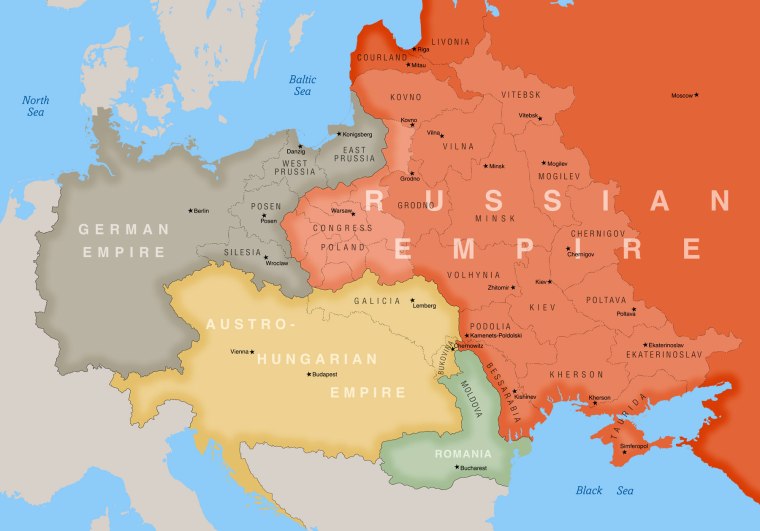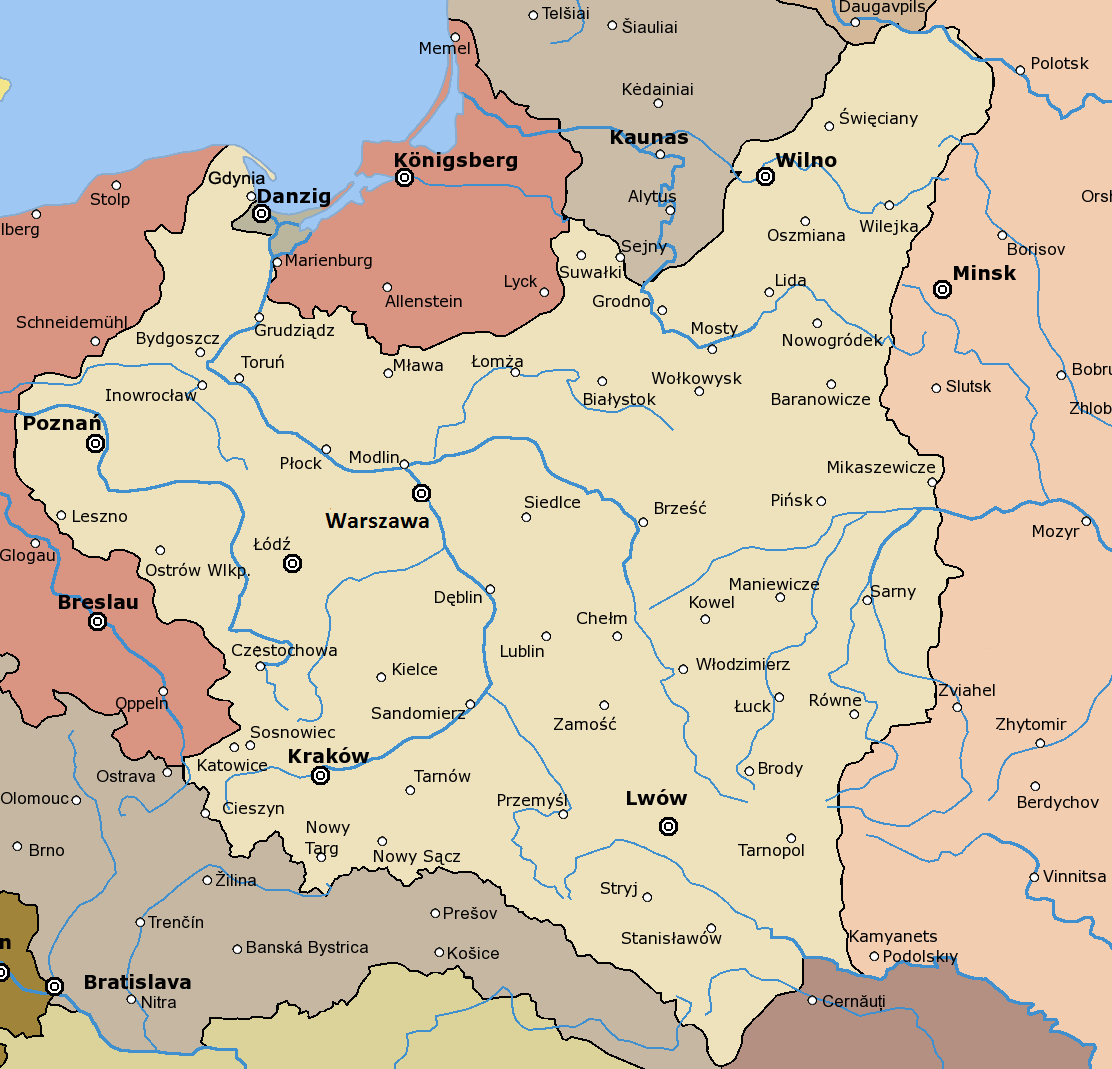I Immigrated to the Us at 30 and Had to Start All Over Again
Newcomers to Polish genealogy often start with a few misconceptions. Many Americans accept only a dim understanding of the border changes that occurred in Europe over the centuries, and in fairness, keeping up with all of them tin be quite a claiming, as evidenced by this timelapse video that illustrates Europe'southward geopolitical map changes since one thousand Advertizing. Then it's no wonder that I ofttimes hear statements like, "Grandma's family was Polish, but they lived someplace near the Russian border." Statements like this presuppose that Grandma's family lived in "Poland" near the border between "Poland" and Russia. Even so, what many people don't realize is that Poland didn't exist as an independent nation from 1795-1918.
How did this happen and what were the consequences for our Polish ancestors? At the risk of vastly oversimplifying the story, I'd like to present a few highlights of Polish history that beginning Shine researchers should be aware of as they start to trace their family'due south origins in "the Old Country."
Typically, the oldest genealogical records that we find for our Shine ancestors date back to the Polish-Lithuanian Commonwealth, which existed from 1569-1795. At the height of its power, the Democracy looked like this (in carmine), superimposed over the electric current map (Figure 1):1
Figure 1: Smoothen–Lithuanian Democracy at its maximum extent, in 1619.ane 
The beginning of the cease for the Commonwealth came in 1772, with the beginning of three partitions which carved up Polish lands amid the Russian, Prussian, and Austrian Empires. The second segmentation, in which only the Russian and Prussian Empires participated, occurred in 1793. After the third partition in 1795, amidst all iii empires, Poland vanished from the map (Effigy 2).
Effigy 2: Map of the Partitions of Poland, courtesy of Wikimedia.2 
This map gets trotted out a lot in Polish history and genealogy discussions because we often explain to people about those partitions, merely I don't especially like it because it sometimes creates the misconception that this was how things nevertheless looked by the late 1800s/early on 1900s when about of our Shine immigrant ancestors came over. In reality, fourth dimension marched on, and the map kept changing. Past 1807, but twelve years after that concluding partitioning of Poland, the brusk-lived Duchy of Warsaw (Figure three) was created by Napoleon as a French client state. At this time, Napoleon likewise introduced a paragraph-fashion format of civil vital registration, and so civil records from this part of "Poland" are hands distinguishable from church records.
Figure 3: Map of the Duchy of Warsaw (Księstwo Warszawskie), 1807-1809.3
During its brief history, the Duchy of Warsaw managed to expand its borders to the southward and eastward a bit thanks to territories taken from the Austrian Empire, equally shown in Figure 4.
Figure four: Map of the Duchy of Warsaw, 1809-1815.4 
However, by 1815, following the terminate of the Napoleonic Wars, the Duchy of Warsaw was divided upwards over again at the Congress of Vienna, which created the Chiliad Duchy of Posen (Wielkie Księstwo Poznańskie), Congress Poland (Królestwo Polskie), and the Gratis City of Kraków. These changes are summarized in Figure 5.
Figure five: Territorial Changes in Poland, 18155 
The Grand Duchy of Posen was a Prussian client land whose capital was the city of Poznań (Posen, in German). This M Duchy was eventually replaced by the Prussian Province of Posen in 1848. Congress Poland was officially known as the Kingdom of Poland but is often chosen "Congress Poland" in reference to its creation at the Congress of Vienna, and as a ways to distinguish it from other Kingdoms of Poland which existed at various times in history. Although information technology was a client state of Russia from the start, Congress Poland was granted some limited autonomy (e.yard. records were kept in Polish) until the November Uprising of 1831, afterwards which Russian federation retaliated with curtailment of Polish rights and freedoms. The unsuccessful January Insurgence of 1863 resulted in a further tightening of Russia's grip on Poland, erasing any semblance of autonomy which the Kingdom of Poland had enjoyed. The territory was wholly absorbed into the Russian Empire, and this is why family historians researching their roots in this area volition see a change from Polish-language vital records to Russian-language records starting about 1868. The Free, Independent, and Strictly Neutral City of Kraków with its Territory (Wolne, Niepodległe i Ściśle Neutralne Miasto Kraków z Okręgiem), was jointly controlled past all iii of its neighbors (Prussia, Russia, and Austria), until information technology was annexed by the Austrian Empire following the failedKraków Uprising in 1846.
By the second half of the 19th century, things had settled downward a bit. The geopolitical map of "Poland" didn't change during the time from the 1880s through the early 1900s, when most of our ancestors emigrated, until the end of World State of war I when Poland was reborn equally a new, independent Polish state. The featured map at the top (shown again in Figure 6) is one of my favorites, considering information technology clearly defines the borders of Galicia and the various Prussian and Russian provinces commonly mentioned in documents pertaining to our ancestors.
Figure 6: Central and Eastern Europe in 1900, courtesy of easteurotopo.org, used with permission.6 
Although the individual provinces within the sometime Congress Poland are not named due to lack of space, a nice map of those is shown in Figure seven.
Figure seven: Authoritative map of Congress Poland, 1907.vii (Notation that some sources even so refer to the these territories as "Congress Poland" even after 1867, only this proper name does not reflect the existence of any contained government autonomously from Russian federation.)
The Republic of Poland that was created at the stop of World War I, commonly known as the 2d Polish Republic, is shown in Figure eight. The borders are shifted to the east relative to present-day Poland, including parts of what is now Lithuania, Ukraine, and Belarus. This territory that was part of Poland between the World Wars, but is excluded from today's Poland, is known as the Kresy.
Figure 8: Map of the Second Polish Republic showing borders from 1921-1939.8 
During the dark days of World War II, Poland was occupied by both Nazi Germany and Soviet Russia. Almost 6 million Polish citizens died during this occupation, mostly civilians, including about 3 meg Shine Jews.nineAfterward the war, the three major allied powers (the U.Southward., Swell Britain, and the Soviet Wedlock) redrew the borders of Europe withal again and created a Poland that excluded the Kresy, just included the territories of East Prussia, Due west Prussia, Silesia, and well-nigh of Pomerania.10, 11 At the aforementioned time,the Western leaders betrayed Poland and Eastern Europe by finer handing these countries over to Stalin and permitting the creation of the Communist Eastern Bloc.12
To conclude, let'due south take a wait at how these border changes affected the village of Kowalewo-Opactwo in present-day Słupca County, Wielkopolskie province, where my great-grandmother was born. This hamlet was originally in the Smooth-Lithuanian Commonwealth, just then became part of Prussia after the second partition in 1793. In 1807 it fell solidly inside the borders of the Duchy of Warsaw, but by 1815 information technology lay right on the westernmost edge of the Kalisz province of Russian-controlled Congress Poland. After 1867, the vital records are in Russian, reflecting the tighter grip that Russia exerted on Poland at that time, until 1918 when Kowalewo-Opactwo became role of the Second Polish Republic. Exercise these edge changes imply that our ancestors weren't Poles, but were really German or Russian? Hardly. Ethnicity and nationality aren't necessarily the same affair. Fourth dimension and fourth dimension once again, ethnic Poles attempted to overthrow their Prussian, Russian or Austrian occupiers, and those uprisings speak volumes almost our ancestors' resentment of those national governments and their longing for a free Poland. As my Polish grandma once told me, "If a true cat has kittens in a china chiffonier, you don't telephone call them teacups."
Sources:
one"Smoothen-Lithuanian Commonwealth at its maximum extent" by Samotny Wędrowiec, is licensed under CC BY-SA 3.0, accessed ix Jan 2017.
2"Rzeczpospolita Rozbiory 3," by Halibutt, is licensed nether CC Past-SA 3.0, accessed 9 Jan 2017.
3 "Map of the Duchy of Warsaw, 1807-1809," by Mathiasrex, based on layers of kgberger, is licensed nether CC BY-SA 3.0., accessed 9 January 2017.
4"Map of the Duchy of Warsaw, 1809-1815" by Mathiasrex, based on layers of kgberger, is licensed nether CC BY-SA 3.0, accessed nine January 2017.
five "Territorial Changes of Poland, 1815," by Esemono, is in the public domain, accessed ix January 2017.
6 "Central and Eastern Europe in 1900," Topgraphic Maps of Eastern Europe: An Atlas of the Shtetl, used with permission, accessed 9 January 2017.
7 "Administrative Map of Kingdom of Poland from 1907," past Qquerim, is licensed under CC By-SA 3.0, accessed 9 Jan 2017.
8 "RzeczpospolitaII," is licensed nether CC By-SA 3.0, accessed ix Jan 2017.
9 "Occupation of Poland (1939-1945)," Wikipedia, accessed ix Janary 2017.
10 "Potsdam Conference," Wikipedia, accessed 9 Jan 2017.
xi"Territorial changes of Poland immediately subsequently Globe War Two," Wikipedia, accessed 9 January 2017.
12 "Western expose," Wikipedia, accessed 9 January 2017.
© Julie Roberts Szczepankiewicz 2017
Source: https://fromshepherdsandshoemakers.com/2017/01/15/those-infamous-border-changes-a-crash-course-in-polish-history/
0 Response to "I Immigrated to the Us at 30 and Had to Start All Over Again"
Post a Comment